-

人教版高中英语必修3Astronomy the science of the stars说课稿3篇
Step 2 Pre-listeningAfter students finish their discussion, I will show a picture of Newton and ask them: Who is him? What is he famous for? Could you find out some words to describe him? Maybe students will answer that he is genius for his finding of theGravitation, making a great contribution to the progress of human being. At that time I will show another two pictures of Einstein and Hawking, letting students guess who they are and write down their idea about the Gravitation. For I have arranged them to search more information about the gravity before this class, Students have beenfamiliar with the topic and will not be afraid about this abstract conception, which is helpful for their listening.Step 3 While-listeningIn this step, students will be required to listen the material for three times. The first and listening is extensive listening and the second and third listening is intensive listening. In the first time, They are required to listen a material including Part 1 and Part 2 and choose the best summary of the listening text. After they choose the right answer, They also need work in group to explain what is wrong with the others. Then I will make a conclusion that we should pay attention to the first paragraph and last paragraph and some keys to get the main idea. By doing this, their capacity of generalization will have a great improvement.Before the second listening, I will ask students to scan the blank on the power point quickly and ask them to note down some key words .Then ask them to listen to the Part 1again and fill the first column of the chart. Maybe some students just show the ideas of these three scientists an still can’t catch their development of gravity. Therefore, I will ask them to listen to Part 2 again and fill in the rest. After finish the listening, I will give them ten minutes to discuss with their partner. I will also guidethem to improve their answers when they discuss with others.

人教版高中英语必修4A taste of English Humor说课稿3篇
Then I would ask them to think of a funny English or Chinese and tell it to partners. While telling stories, they can use expressions and some acting to help make the story funny. 5 minutes would be given to do this.Those stories they told there will be the material for their writing. Soletting them tell it at first is helpful. And they can make a difference between telling a funny story and writing it down. Generally speaking, it is difficult forstudents to write well because they don’t know what to write and how to write. Asking them to tell their own stories at first can help them come up with what to write.After their telling, I would invite someone to share his/her story with all of us and I would write it down on the blackboard.This example story would be used as a sample to illustrate the format of funny story. Different from a story from teacher or textbook, a story from students can obviously become a interesting material to draw students’ attention.Then I would ask the whole class to put this story into several parts. It might be a little bit difficult for them. So I would ask them to find out whether all the sentences are necessary. After delete some sentences, there are 6 sentences left behind. Then they can easily put them into three parts. After interaction with students, I would teach them the right terms for each part and conclude the format of funny story.This step is the key and difficult point in my lesson. So I mainly usetask-based teaching method in this part and the task for students was divided into several stages. With the separated difficult level, students can find there are usually three parts in writing. They can also learn to write without the unnecessary parts in the process of analyzing. And then I wouldn’t rush to tell them the right terms to them directly. Instead, I would ask them to name them by their own. A confused mind is better for acquiring knowledge.While-writing:Then I would give students 7 minutes to write down this story, without other requirements.With all the preparations in pre-writing, students’ difficulties were cleared. So it would be much easier for them to write down the story within 7 minutes. There are no other requirements because students’ first writing is actually a drafting. It would be revise and edit several times later. Writing, as a skill

人教版高中英语必修3Canada-the true north说课稿4篇
Good afternoon, teachers, It’s my great pleasure to be here sharing my lesson with you.The content of my lesson is Senior English Book 3 Unit 5 Canada —— “The true North”.I’ll be ready to begin this lesson from five parts. Analysis of the teaching material,the teaching methods,the studying methods, the teaching procedure,and Blackboard design.First, let me talk about the teaching material.Part 1 Teaching Material:This unit is about the introduction of Canada. By studying of this unit,we’ll enable the students to learn the geography, population, main cities, and natural beauty, natural resources of Canada. Through the training of the unit, it also requires students to learn some Language skills such as the expressions of position and emotions.So it plays an important part in the English teaching in this book.After studying the teaching material and analyzing the rule of children’s growing of mind,I think the teaching aims are the followings:1.Knowledge objects:(1) make the students learn some new words and phrases(2) make the students understand the content of the lesson.2.Ability objects:(1)To develop the Ss’ abilities of listening, speaking, reading and writing. Especially reading and speaking ability.(2) learn to talk about the characters of Canada in English(3)To train the Ss’ ability of working in pairs.3.Emotion objects:(1)Enable students to understand the characters of Canada..(2)Stimulate Ss to work hard to make China stronger.Part 2 Teaching Methods:I think helping students learn to master new words and phrases and improve the students’ reading and speaking ability is import and the difficult.According to the analysis of the teaching material and the import points and the difficult points,I will use the following teaching methods : question-guiding approach; fast-reading and careful reading; multi-media teaching methods; discussion

人教版高中英语必修3Festivals around the World说课稿3篇
Teaching plan for Unit 1 book3Good morning, teachers. It’s my great pleasure to be here because I can share my lesson with you and I can learn a lot from it. I’ll begin my lesson from the following four parts, the teaching material, the teaching methods, the studying methods and the teaching procedure.Firstly, let me talk about the teaching material. The content of my lesson is the reading passage festivals and celebrations of Unit 1 Festivals around the world. This passage is about festivals and celebrations. By studying this passage, we’ll enable the students to know that festivals exit everywhere, and many of festivals in different countries celebrate similar ideas. As we all know, the reading passage is the center of each unit. If the Ss can learn it well, it will be helpful to make the Ss learn the rest of this unit.After studying the teaching material, I think the teaching aims are as the followings:1. Knowledge aims:(1) The Ss can master the usage of the important words andexpressions.(2)The Ss can use the __________________ (grammar) in the proper situation.Make students know about the festivals all over the world and the detail of the festivals, such as origin, content, and the date of the holiday festivals.2. Ability aims:(1) Students can talk about festivals and celebrations in English(2) To improve the student’s reading ability, especially their skimming and scanning ability.3. Emotion aims:Make the Ss know about the foreign festivals, and respect other countries’ custom.Next, let’s come to the important points and the difficult points.The important point is how to make the Ss understand the text better and the difficult point is how can they talk about it. secondly, Teaching Methods:1. task-based Language Teaching2. Computer assisted language teaching.3. question-and–answer methodThirdly, Studying Methods:

人教版高中英语必修4Theme parks说课稿3篇
The oldest and the most popular park in the worldenjoy the exciting activities thereget close to the life-size cartoon characters like Mickey Mouse and Donald Duck Step 3 Pre-reading1.What do you suppose a theme park is ?2.What do you think you can see in a theme park?(1.It is a kind of amusement park which has a certain theme – that the whole park is based on. 2.buildings, castles, statues, rare animals and birds, and so on.) Step 4 Reading ----- Theme Parks –---- Fun and More Than Fun1.Predict : Read the title and the pictures on P. 34 and PredictWhat is the meaning of the title “Theme Park – Fun and more than fun”?(The title means that theme parks are fun to visit, but that they can also be educational and can offer useful information.)2.Skimming Fast read and answer:What activities can we take in a theme park?Amusement park: Bumper car Merry-go-round slide bungee jumping Free-fall rides Horror films Pirate ship Ferris wheel roller coaster3.Scanning Read again and you will find various theme parks are mentioned in the passage . Then what are they ?Theme parks: Sports theme park History theme park Culture theme park Marine or Ocean theme Park Future park Science theme park Disneyland4.Careful reading and find the main idea of each paragraph:THEME PARKS---- entertaining/ educationalPara.1 Traditional parks are places to go for relaxation and to have time away from our busy lives.Para.2 Theme parks are different They’re large and full of things to do, see and buy.Para.3 Theme parks are built around a single idea or theme. One example is a sports park.Para.4 Another kind of theme park is historical more and cultural and can be educational.Para.5 Disneylandwas the first theme park. It is based on the fantasy life and characters of Disney’s films.Para.6 Some examples of educational theme parks include sea world parks and science parks.

人教版高中英语必修4Working The Land说课稿3篇
Knowledge objectives:(1) to make Ss grasp the usage of words, expressions and sentence structures: statistics, struggle, thanks to, rid of, some patterns for persuasion, the “ing” form as subject and object;(2)to use learnt knowledge to persuade sb.Ability objectives:(1) to develop Ss’ reading skills(skimming, scanning, word guessing);(2) to improve Ss’ speaking, communicating and cooperating skills.Emotional objectives:to make Ss know the contribution of Yuan,and learn his spirit and his simple life time.Teaching important and difficult points:(1) some words, expressions and sentence structures mentioned above;(2)the content of the text;(3)training their reading and speaking skills.Teaching methods: CLT, TBLT,QT.Learning strategies: CLS, QLS, TBLS.Teaching procedures:Step 1 lead-in: (1) teacher plays a piece of recent news from CCTV about the harvest of the super hybrid rice, and ask students whether they know Yuan or not, and talk about him and his contribution.(2)Brain storm: let Ss describe Yuan in their minds including his appearance, his living condition and so on.Step 2 fast reading tasks:(1)teacher introduces Yuan and super hybrid rice(2)make Ss read the text as fast as possible with questions. Such as: what’s the general ideaof this passage? What’s Yuan’ dream? (skimming and scanning skill)Step 3 intensive reading tasks(1)let Ss read the text silently, find topic sentence of each paragraph and draw the difficult sentences and the knowledge what they don’t understand.(words guessing)(2)teacher and Ss talk about the important words, expressions and sentences together, and ask Ss to retell the content of the text.(summarizing and paraphrasing)(3)teacher summarize this part.(4) read again following the courseware.

人教版高中英语必修3The million pound bank note说课稿3篇
在接下来的细读环节,我套用了高考对阅读理解的考查方式设置了5个问题,分别为三个推理判断题,一个细节题和一个主旨大意题。学生需要对文章的内容进行分析、归纳、推理、猜测等高级思维活动才能做出正确的回答。【设计意图】这一过程是对学生进行细读的训练,培养学生获取特定信息和挖掘文章深层次信息的能力。第三环节:Intensive-reading (精读) 15′第三个环节精读,既是最重要的环节,也是突破本课重难点的关键。首先,让学生思考剧本中人物看到百万英镑前后的态度发生了怎样的变化。其次,让学生仔细阅读文章,找出可以表现人物态度变化的具体的语言和动作。最后,让学生总结人物的态度发生变化的根本原因是什么,从而引出Money Talks, 供学生思考。【设计意图】通过一系列的活动培养学生学习从人物的语言和动作探究人物的心理,使学生进一步体会戏剧语言的魅力,从而对文章背后所反映的社会问题进行思考,也为下一步的讨论环节做好铺垫。

人教版高中英语必修5Great scientists说课稿4篇
通过写文章梗概,培养学生综合运用语言的能力,学习用恰当的英语描述科学家的故事。这是本课的教学难点。教师可以使用完形填空的方式来帮助学生整理语篇,从而来降低难度。本课的教学重点的突破方法是:在阅读前,让学生初步了解得出科学观点所需要的基本程序,从而轻松而自然地导入文章的阅读;在阅读过程中,由易到难设计快速阅读和精读的问题,层层推进各种阅读活动,让学生对阅读内容从整体感知到细节理解,最后深层读懂整篇文章,同时加强阅读策略的指导,让每个学生都主动参与课堂教学活动,最终达到提高阅读能力的目的。Step 4 Post-readingGroup Activities四人小组共同合作,在老师的适当指导下,就以下2个问题展开讨论,让学生就所知、所学、所感和所想融入话题,然后抽若干同学代表作小组发言。1. What do you think about John Snow, and what should we learn from him?2. Cholera was 19th century disease, which two diseases are similar to cholera today? Why?

人教版高中英语必修5Life in the Future说课稿5篇
Good afternoon, everyone. It’s my great pleasure to be here sharing my lesson with you. The content of my lesson is Senior English for China Book5 Unit 3 Life in the Future. I’ll be ready to begin this lesson from six parts: Analysis of the teaching material, Analysis of the students, Teaching aims and important and difficult points, Teaching methods and aids, Teaching procedures, and Blackboard design. First, let me talk about the teaching material.Part 1 Analysis of the Teaching Material:This unit is about what human beings’ life will be like in about one thousand years. By studying of this unit, we’ll Enable the students to know the changes in humans’ life and some new inventions bringing about the change and develop the interest in science. This lesson plays an important part in the English teaching in this unit. This is an important lesson in Book Five. From this lesson, it starts asking the Ss to grasp contents of each passage. Therefore, this lesson is in the important position of the teaching material. If the Ss can learn it well, it will be helpful to make the Ss learn the rest of this unit.Part 2 Analysis of the SsAs Senior2 Ss, they are at different levels of English fluency, some of them have lost interest in English. So during the lesson, I arrange a variety of activities to let all of them join in to attract their interest and let them be confident and taste the joy of success.

人教版高中英语必修5The United Kingdom说课稿4篇
Teaching Aims:Knowledge 1. Get the students to learn the useful new words and expressions in this section. Aims:2. Let the students learn about how the UK was formed and the four groups of invaders.1. Develop students’ reading ability and let them learn different Ability reading skills. Aims:2. Enable students to learn to talk about the United Kingdom and the Union Jack Emotional 1. Let students know more about the UK2. Develop students’ sense of cooperative learning Aims:Teaching Important Points:1. Let the students learn about the countries of the United Kingdom and the Union Jack2. Get the students to read the passage and know about how the UK was formed and the four groups of invaders.3. Have the students learn different reading skills.Teaching Difficult Ponts:1. Develop students’ reading ability.2. Enable students to talk about the United Kingdom and the Union Jack.3. Let students learn how the UK was formed geographically and historically.Teaching Methods:Showing pictures, asking, exercising, listening, reading etc.Teaching Aids:A computer,a projector and a blackboard.Teaching Procedures: 1) Show a map of the world, ask students the following questions:Where is the UK?What’s the full name of the UK?2) Ask the students work in pairs to do the quiz on Page 9.Do you want to test how many things you know about the United Kingdom? Let’s have a small test.Using the map on P9, students answer the following questions:?How many countries does the UK consist of? What are they??England is divided into three main areas. Do you know what they are? 1) Scanning (10Minutes )Let the students hold the questions asked in pre-reading and read the passagequickly and then let them do the following exercise.Join lines to the right answer.
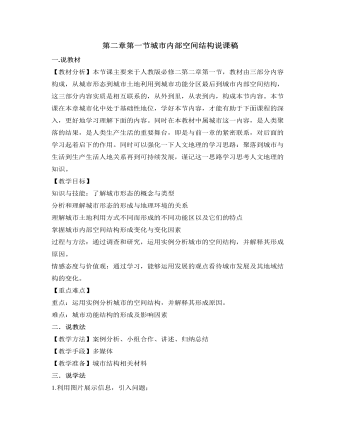
人教版高中地理必修2第二章第一节城市内部空间结构说课稿
提问:结合课本找出城市地域结构模式的类型及各自特点,模式形成的因素又有哪些?学生回答,使其掌握基本模式及特点,通过对比,分析把握每一模式各自的特征,学会把握事物本质。◆设计意图:阅读课本,总结归纳,同时引导,通过原因规律的探究,大胆设想,总结规律掌握人文地理学习思路。4.活动设计:内部空间结构变化,结合实例,分析说明。提问:结合江宁区的变化,分析江宁区城市结构发生了哪些变化?结合课本24页活动题,提出功能结构布局方案?通过理论联系实际,让学生更好理解理论,掌握城市结构布局的变化及其影响因素,通过活动题方案的提出,学生能够掌握布局的规律性,解决问题。设计意图:理论联系实际,知识的不枯燥性,提高学生学习兴趣。同时,能够通过总结,深层次认识城市结构布局,活学活用。
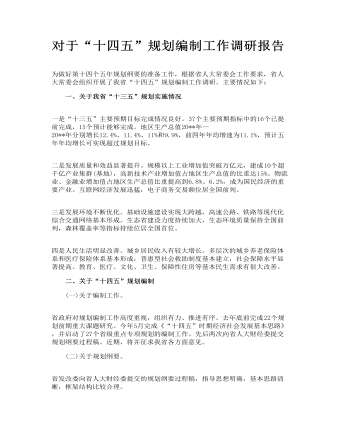
对于“十四五”规划编制工作调研报告
一是“十三五”主要预期目标完成情况良好。37个主要预期指标中的16个已提前完成,15个预计能够完成。地区生产总值20**年—20**年分别增长12.4%、11.4%、11%和9.9%,前四年年均增速为11.1%,预计五年年均增长可实现超过规划目标。 二是发展质量和效益显著提升。规模以上工业增加值突破万亿元,建成10个超千亿产业集群(基地),高新技术产业增加值占地区生产总值的比重达15%。物流业、金融业增加值占地区生产总值比重提高到6.8%、6.2%,成为国民经济的重要产业。互联网经济发展迅猛,电子商务交易额位居全国前列。
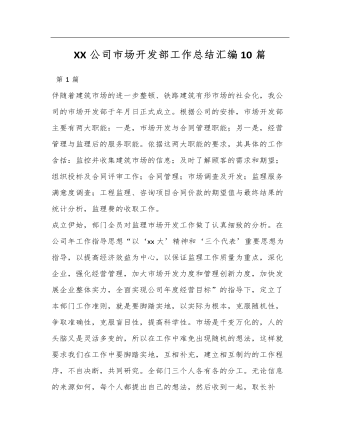
(10篇)XX公司市场开发部工作总结汇编
在进行产品开发的同时,我也对公司非门票经营产业结构进行了全面而深刻的剖析。产业结构单一,竞争中不能形成绝对优势,消费形不成规模等等问题是制约华清池非门票经营的一道壁垒。在公司确定以“项目发展带动经营创收”的基本思路,在中心主任的帮助下,我和产品开发部成员一起,积极策划梨园、龙石舫等闲置场所的利用方案,一是经过多处实地查看、沟通,将梨园定位为集梨园文化展览、旅游纪念品消费和高端商务会所与一体的综合性消费场所;二是组织完成了梨园设计招投标工作;三是完成了梨园内部装饰拆卸和基础改造咨询、手续办理等工作;在龙石舫等其他闲置场所利用方面,一是通过在龙石舫一周调研,了解龙石舫消费人群构成,最终确定以散客目标人群,并确定改造为休憩、观光为一体的西式饮品消费场所,目前基础改造正在进行,内部装修方案正在进行方案修改。二是通过总结经营实践中问题和与多次沟通、了解,确定将西配殿定位为长恨歌纪念品专营店,目前西配殿改造方案正在进行二稿修改。三是拟定了白莲榭、龙吟榭、长生殿等场所的经营概念性思路策划方案草拟稿。四是完成了华清池非门票经营三年规划,为公司非门票经营提供了思路。
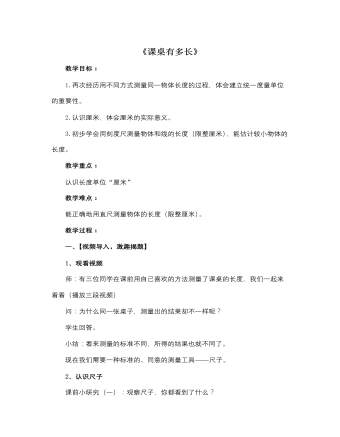
北师大版小学数学二年级上册《课桌有多长》说课稿
教学目标:1.再次经历用不同方式测量同一物体长度的过程,体会建立统一度量单位的重要性。2.认识厘米,体会厘米的实际意义。3.初步学会用刻度尺测量物体和线的长度(限整厘米),能估计较小物体的长度。教学重点:认识长度单位“厘米”教学难点:能正确地用直尺测量物体的长度(限整厘米)。教学过程:一、【视频导入,激趣揭题】1、观看视频师:有三位同学在课前用自己喜欢的方法测量了课桌的长度,我们一起来看看(播放三段视频)问:为什么同一张桌子,测量出的结果却不一样呢?学生回答。小结:看来测量的标准不同,所得的结果也就不同了。现在我们需要一种标准的、同意的测量工具——尺子。2、认识尺子课前小研究(一):观察尺子,你都看到了什么?介绍刻度、刻度线、厘米。
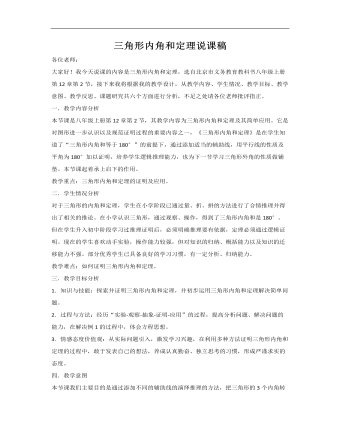
初中数学北京课改版八年级上册《122三角形的性质》说课稿
一.学生情况分析对于三角形的内角和定理,学生在小学阶段已通过量、折、拼的方法进行了合情推理并得出了相关的推论。在小学认识三角形,通过观察、操作,得到了三角形内角和是180°。但在学生升入初中阶段学习过推理证明后,必须明确推理要有依据,定理必须通过逻辑证明。现在的学生喜欢动手实验,操作能力较强,但对知识的归纳、概括能力以及知识的迁移能力不强。部分优秀学生已具备良好的学习习惯,有一定分析、归纳能力。
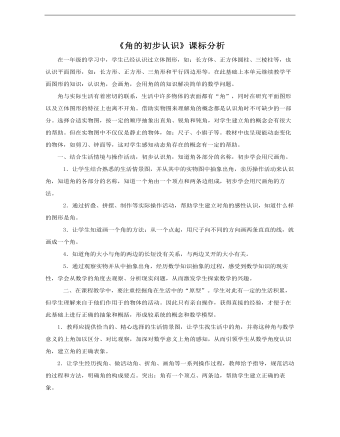
小学数学青岛版二年级上册《角的初步认识》课标分析说课稿
一、结合生活情境与操作活动,初步认识角,知道角各部分的名称,初步学会用尺画角。 1.让学生结合熟悉的生活情景图,并从其中的实物图中抽象出角,亲历操作活动来认识角,知道角的各部分的名称,知道一个角由一个顶点和两条边组成,初步学会用尺画角的方法。 2.通过折叠、拼摆、制作等实际操作活动,帮助学生建立对角的感性认识,知道什么样的图形是角。 3.让学生知道画一个角的方法:从一个点起,用尺子向不同的方向画两条直直的线,就画成一个角。 4.知道角的大小与角的两边的长短没有关系,与两边叉开的大小有关。 5.通过观察实物并从中抽象出角,经历数学知识抽象的过程,感受到数学知识的现实性,学会从数学的角度去观察、分析现实问题,从而激发学生探索数学的兴趣。 二、在课程教学中,要注重挖掘角在生活中的“原型”。学生对此有一定的生活积累,但学生理解来自于他们作用于的物体的活动。因此只有亲自操作,获得直接的经验,才便于在此基础上进行正确的抽象和概括,形成较系统的概念和数学模型。1.教师应提供恰当的、精心选择的生活情景图,让学生找生活中的角,并将这种角与数学意义的上角加以区分、对比观察,加深对数学意义上角的感知,从而引领学生从数学角度认识角,建立角的正确表象。
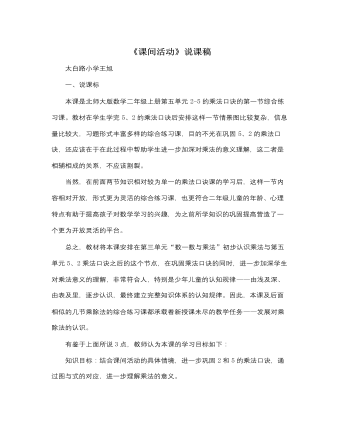
北师大版小学数学二年级上册《课间活动》说课稿
根据教师之前对课标及本课教材内容的分析,教师认为本课的教学重点应该是,结合课间活动的具体情境,进一步巩固2和5的乘法口诀,通过图与式的对应,进一步理解乘法的意义。教学难点是发展学生对乘法的认识,包含在教学重点之中。教学重难点的突破,教师准备围绕教材所设计的四个侧重点不同的问题,以教材的第一个问题——图与式的对应(数形结合、逆向思维)、第二个问题——根据数学信息解决实际问题(正向思维),逆正两种思维方式帮助学生理解巩固乘法的意义,同时,在解决教材的第三个问题“一共有多少盆花”后,帮助学生初步认识到乘法的局限性——不能解决加数不相同的几个加数的和。在学生知道了乘法的能和不能,进一步界定了乘法概念的内涵后,通过认知发散,找一找自己课间活动中能用乘法解决的问题,帮助学生将对乘法的认知扩展到日常生活的应用层面,从而达到其对乘法的进一步理解的目的。同时,随着这四个问题的解决,5、2的乘法口诀也在计算中得到了练习巩固。
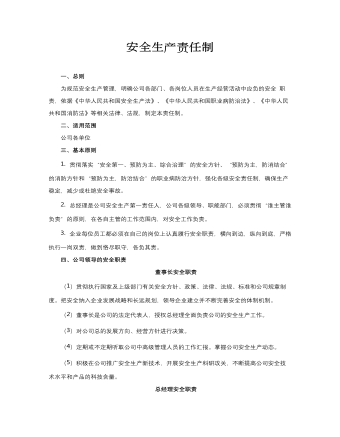
化工公司安全生产规章制度汇编资料
1. 贯彻落实“安全第一、预防为主、综合治理”的安全方针、“预防为主,防消结合”的消防方针和“预防为主,防治结合”的职业病防治方针,强化各级安全责任制,确保生产稳定,减少或杜绝安全事故。2. 总经理是公司安全生产第一责任人,公司各级领导、职能部门,必须贯彻“谁主管谁负责”的原则,在各自主管的工作范围内,对安全工作负责。3. 企业每位员工都必须在自己的岗位上认真履行安全职责,横向到边,纵向到底,严格执行一岗双责,做到恪尽职守,各负其责。
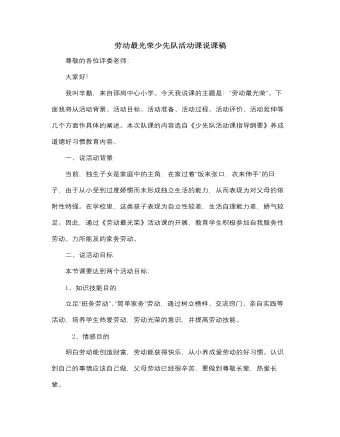
人音版小学音乐一年级上劳动最光荣少先队活动课说课稿
4、争当班级小主人,为集体出力(建立班集体岗位责任制)五、说活动评价评价激励手段辅导员评价:主要以班级发展主题图中的奖励为主。队员评价:过程评价以星和小奖章记录为主。六、说活动延伸?课后各小组建立岗位责任制,全班每个同学都负责一个地方,承担一个责任,由小组长负责和组员讨论如何划分责任区。下周开始执行。最后我想,我们少先队活动课最大的特点就是在活动中体验、在活动中成长。活动全程,队员们的组织能力、观察能力、思考能力、统计能力、团队合作能力、生活能力都得到了锻炼与成长,这就是我们组织少先队活动最大的收获。我们有责任和义务开展好少先队活动课,真正的实现以学生为中心,为学生的长远发展负责,使少先队活动课真正成为育人、育心的课程,更好的为生活服务。以上,就是我对《劳动最光荣》这节少先队活动课的阐述。存在的不足之处还恳请各位评委老师批评指正。谢谢大家!
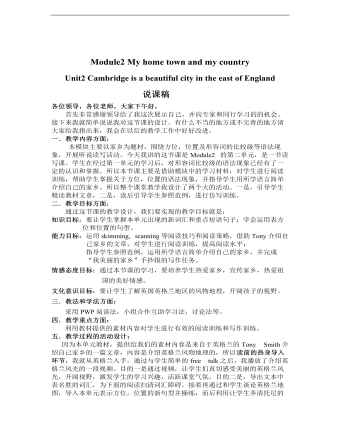
初中英语外研版八年级上册《Module 2 My home town and my countryUnit 2》说课稿
一.教学内容方面:本模块主要以家乡为题材,围绕方位,位置及形容词的比较级等语法现象,开展听说读写活动。今天我讲的这节课是Module2 的第二单元,是一节读写课。学生在经过第一单元的学习后,对形容词比较级的语法现象已经有了一定的认识和掌握。所以本节课主要是借助模块中的学习材料,对学生进行阅读训练,帮助学生掌握关于方位,位置的语法现象,并指导学生用所学语言简单介绍自己的家乡。所以整个课堂教学我设计了两个大的活动。一是,引导学生精读教材文章,二是,读后引导学生参照范例,进行仿写训练。
